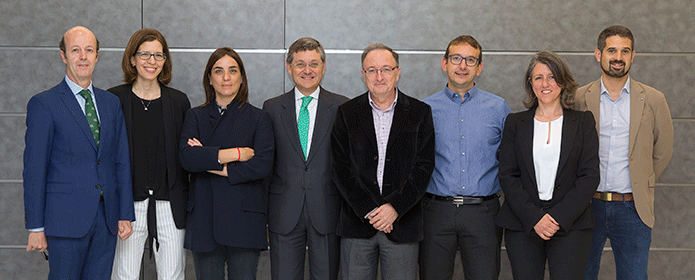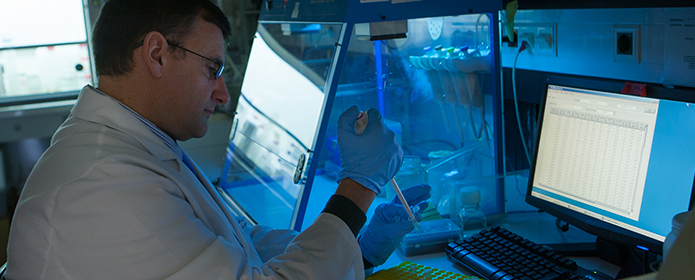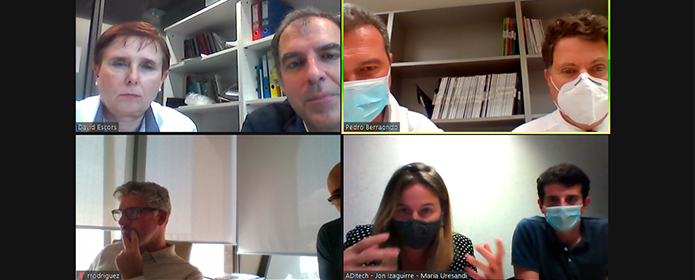Bioengineering to advance tissue regeneration
The Cima and the Clínica Universidad de Navarra organize an international symposium to present the latest advances in research and treatment.

One hundred experts gathered at the Cima University of Navarra to participate in the international symposium "Towards a new frontier: tissue engineering at the service of biomedicine". At the meeting, organized by the Clínica Universidad de Navarra at partnership with the Cima, the latest advances in research and treatment with the application of this technology were presented. According to Dr. Manuel Mazo, researcher of Cima and one of the organizers of the scientific meeting , "advances in biomedicine have become a revolution, not only in the most basic research but also in the development of new therapies and design of new equipment".
Tissue engineering, or bioengineering, sample its potential in three main areas: 3D printing of human tissues or organs (additive manufacturing), cell reprogramming (possibility of generating any cell of the adult organism) and biomaterials development (employment of biological materials, such as skin or blood, to restore living tissues or organs and their functions).
3D PrintingAmong the therapeutic applications in the field of bioengineering, 3D printing of biomaterials offers one of the most important. "We can fabricate three-dimensional Structures on which biological tissues can grow and regenerate tissues that are deteriorated or defective," stresses Elena De Juan-Pardo, a biomedical engineer at Queensland University of Technology (Australia). "Three-dimensional printing allows us to manufacture scaffolds on which cells can find a guide to remember what they have to do," says the expert.
In the opinion of Dr. Felipe Prósper, director of the Regenerative Medicine Program at Cima and area of Cell Therapy at Clínica Universidad de Navarra, "the artificial fabrication of tissues and organs for patients suffering physiological deterioration is a real revolution. Although it is a very complex technique, since it is necessary to manufacture different components that include extracellular tissues, the cells themselves and the development of the complete gear, it has already begun to be applied to relatively simple organs, such as a nose or a bladder".
On the other hand, in the case of more complex organs, such as the heart or liver, there are ongoing clinical trials at programs of study in which parts of an organ or specific tissues are replaced with very promising results. Specifically, Dr. Prosper's team is working on the generation of cardiac tissue for patients who have suffered a myocardial infarction. In these cases, although survival at the time of the infarction is high, after five years it decreases and also requires intense polypharmacy. This project aims to offer a therapeutic solution by generating human cardiac tissue, joining cardiac cells (derived from stem cells) together with advanced 3D printing technology and biomaterials. It has been successfully tested in animals, now researchers seek to progress its application in humans.
Microchip to detect cardiotoxicityDuring the symposium, a microchip capable of detecting drug cardiotoxicity, the leading cause of drug recalls by pharmaceutical companies, was presented. One third of the compounds targeted for therapy in humans are eliminated for this reason.
Regarding technological innovations, a normothermic perfusion machine for liver and kidney transplantation was presented, i.e., a technology capable of extending the "life" of these organs, making it possible to reach more patients. In turn, Dr. Manuel Doblaré, an expert in research computational and biomechanics, presented a research performed in silico (by computer) to learn how biological tissues function. Thanks to this technology, it is possible to predict the evolution of a tissue that has suffered an injury when, for example, a prosthesis is to be fitted.
This workshop, organized by the area of Cell Therapy of the Clinic, in partnership with the Regenerative Medicine Program of Cima, has been developed thanks to the project Interreg Poctefa Healthcare LSR, a project of research of development of innovative activities of cross-border character in the health sector, co-financed by the European Regional Fund development .




